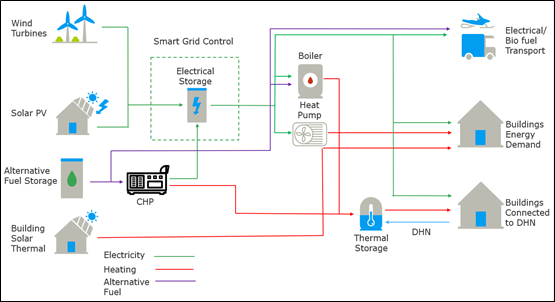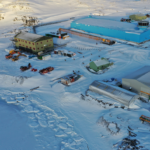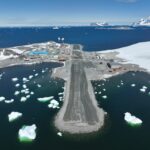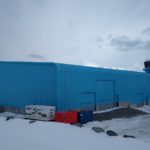The British Antarctic Survey (BAS) operates in the most remote places on earth including the Antarctic, the Southern Ocean and the Arctic. The challenges around logistics and extreme weather conditions entail many risks associated with energy security, fuel dependency and carbon emissions. Future-proofing BAS against these risks is a high priority.
In order to future-proof BAS’s capacity to continue to deliver world-class environmental science and contribute to the global effort of addressing climate change, BAS has committed to achieve net zero carbon emissions from our directly owned operations before 2040. Committing to climate action and developing an ambitious vision for the future will help BAS remain at the forefront of climate science, influence and drive change within its supply chain and beyond.
As part of the efforts to decarbonise the BAS Estate in Antarctica, the Rothera Renewable Energy Project aims to identify the road map to transition the current energy system on station, to renewable energy technology over the next ten years. The station predominantly relies on fossil fuels to meet the power, space heating and hot water demands. Diesel generators provide power for lighting, kitchen utilities, potable water production and diesel fired boilers for the central heating system and hot water. Solar photovoltaics (PV) and solar thermal panels are also installed on a number of buildings and supply a small amount of heat and power to the station.
The first step of the Rothera Renewable Energy Project is to ensure robust renewable energy technologies are considered through comprehensive feasibility studies, trialling of prototypes where appropriate and enabling works. The results of this preliminary work will feed into and define a sustainable energy strategy for Rothera aligned to the Rothera Decarbonisation Strategy. Initial indications suggest that a multi-faceted technological approach will be required to deliver the new energy strategy. The approach currently being considered is comprised of the following activities:
- electrification of the station using proven renewable energy generation;
- use of sustainable biofuels for back up and resilience;
- energy demand reduction activities; and
- investigation into innovative energy technologies and solutions for future implementation.
Inevitably working in such a remote location with extreme weather conditions and sensitive ecology there are a number of challenges to address in order to decarbonise need to be considered and fully assessed before a renewable energy strategy can be implemented. These include:
- Intermittency of renewable energy systems mean that reliable energy storage and management must be incorporated into the system. A robust and reliable energy system is essential to provide life support to those living on station;
- Extreme weather conditions affecting the operation of renewable energy systems (ice on wind turbine blades, snow cover on PVs, daylight for half of the year);
- Environmental impacts of renewable energy systems on local wildlife (birds, seals);
- Potential disruption to the delivery of science (if new systems are planned to be installed at locations where scientific equipment is currently installed, as well as potential electromagnetic interference from energy systems in the vicinity of science equipment;)
- Technology barriers for decarbonising shipping, aviation and vehicles (maturity and commercialisation status);
- Requirement of multi-skilled staff on station to service and maintain a range of different energy systems that can be quite complex;
- Minimal available space for the installation of renewable energy systems, for example, ice free ground for wind turbine installation or roof space for solar PVs;
- Availability of a secure supply of sustainable alternative fuels, suitable for cold conditions at an affordable price; and
- Capital, operational and replacement expenditures as well as whole life carbon costs (CAPEX, OPEX, REPEX).
Figure 1 is an illustration of the technologies which are currently being considered to deliver the core energy requirements at Rothera.

Figure 1. Schematic of the potential energy system at
All activities in Antarctica are subject to Environmental Impact , an EIA will be submitted to the Foreign Commonwealth and Development Office for consideration and approval.
10 July, 2024
Construction teams have completed significant stages of the British Antarctic Survey’s (BAS) Antarctic Infrastructure Modernisation Programme and joined the over-wintering staff for the first time as the 2023/24 summer season ended. The improvements, led by BAM and technical advisors Ramboll will transform future science and operations at Rothera, the UK’s largest polar research station in Antarctica.
4 March, 2024
As part of the British Antarctic Survey’s Antarctic Infrastructure Modernisation Programme (AIMP), the runway at Rothera research station has successfully been resurfaced by construction company BAM and the design completed by Ramboll. The station is a major hub for international science in Antarctica, and this significant achievement is a pivotal moment for BAS and the UK’s future polar research capabilities.
3 April, 2023
A new scientific and operational support facility at Rothera Research Station for British Antarctic Survey has been made weathertight, with the cladding complete and an operations tower installed.



